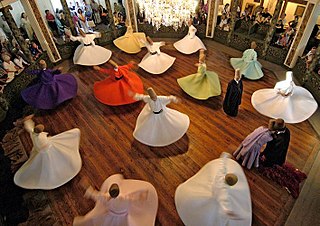 W
WAlmah or Almeh was the name of a class of courtesans or female entertainers in Egypt, women educated to sing and recite classical poetry and to discourse wittily, connected to the qayna slave singers. They were educated girls of good social standing, trained in dancing, singing and poetry, present at festivals and entertainments, and hired as mourners at funerals.
The Badlah or Badlet Ra'as is a traditional Egyptian folklore costume mostly worn by women, but in some Egyptian weddings men dancers wear it too. The word badlah is an Egyptian Arabic for "suit".
 W
WBaladi can refer to an Egyptian musical style, the folk style of Egyptian bellydance, or the Masmoudi Sogheir rhythm, which is frequently used in baladi music. It is also sometimes spelled in English as 'beledi' or 'baladee'.
 W
WBelly dance; more correctly referred to as Raqs Sharqi is an Arabic expressive dance that has its origins in Egypt since ancient times. It features movements of the hips and torso. It has evolved to take many different forms depending on the country and region, both in costume and dance style; with Egyptian style the most recognized worldwide due to the Egyptian cinema. It is popular worldwide with many schools around the globe now practicing it.
 W
WThe Ghawazi is a local practice describing female dancers who dance inreturn of money, meanwhile the men version of the practice is described as "khawal". They first started as few Egyptian Gypsies who refused to dance for free unlike the common habit among all Egypt, then the idea got extensively practiced and got developed among rural Egyptians or Fellahin, who also developed a more rural and traditional style accompanied by Rural Egyptian songs and colorful dresses of the Fellahin and became a theme of Rural Egypt. Over the years, Upper Egyptians (Sa'idis) mastered and then developed a different style of traditional Saidi dancing that's accompanied by Egyptian mizmar flute and Qena and Assuit's traditional female clothing of Telli (Egyptian Arabic: تلي)) , a super silky type of local fabric. That Upper Egyptian style is the most famous, where the dancer is accompanied by a traditional Upper Egyptian Mizmar and a singer singing and narrating folk-songs in "Saidi Arabic" about local hereos and popular love stories in towns.
 W
WRaqs sharqi is the classical Egyptian style of belly dance that developed during the first half of the 20th century.
 W
WTahtib is the term for a traditional stick-fighting martial art originally named fan a'nazaha wa-tahtib. The original martial version of tahtib later evolved into an Egyptian folk dance with a wooden stick. It is commonly described in English as a "stick dance", "cane dance", "stick-dancing game", or as ritual mock combat accompanied by music. Nowadays, the word tahtib encompasses both martial practice and performance art. It is mainly practiced today in Upper Egypt. Tahtib is regularly performed for tourists in Luxor and Aswan.
 W
WSufi whirling is a form of physically active meditation which originated among certain Sufi groups, and which is still practiced by the Sufi Dervishes of the Mevlevi order and other orders such as the Rifa'i-Marufi. It is a customary meditation practice performed within the Sema, or worship ceremony, through which dervishes aim to reach the source of all perfection, or karma. This is sought through abandoning one's nafs, ego or personal desires, by listening to the music, focusing on God, and spinning one's body in repetitive circles, which has been seen as a symbolic imitation of planets in the Solar System orbiting the sun.